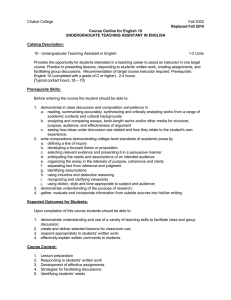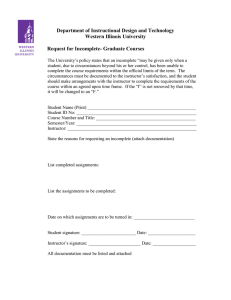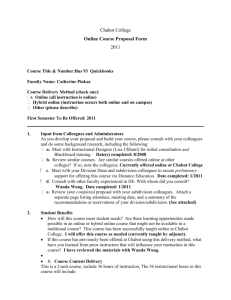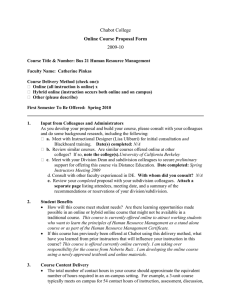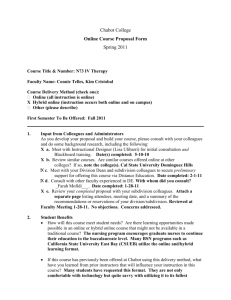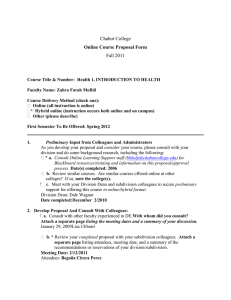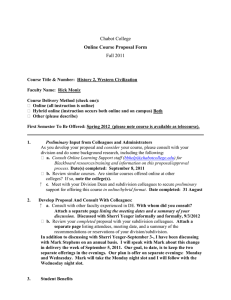Chabot College 2009-10 Online Course Proposal Form
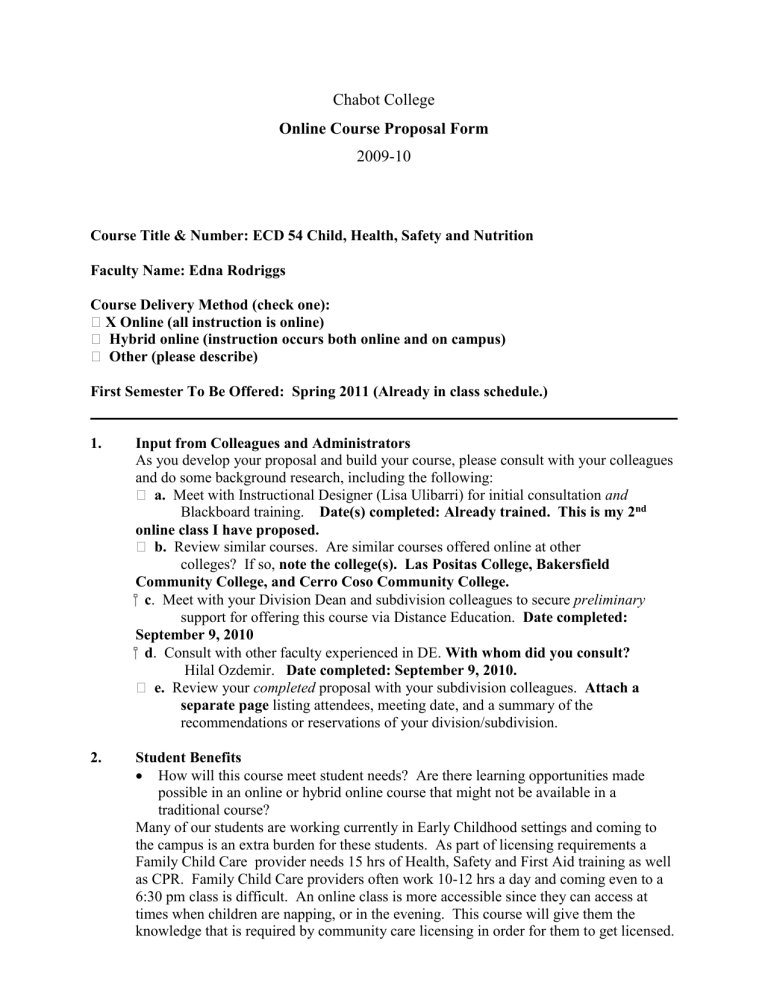
Chabot College
Online Course Proposal Form
2009-10
Course Title & Number: ECD 54 Child, Health, Safety and Nutrition
Faculty Name: Edna Rodriggs
Course Delivery Method (check one):
X Online (all instruction is online)
Hybrid online (instruction occurs both online and on campus)
Other (please describe)
First Semester To Be Offered: Spring 2011 (Already in class schedule.)
1.
Input from Colleagues and Administrators
As you develop your proposal and build your course, please consult with your colleagues and do some background research, including the following:
a. Meet with Instructional Designer (Lisa Ulibarri) for initial consultation and
Blackboard training. Date(s) completed: Already trained. This is my 2 nd online class I have proposed.
b.
Review similar courses. Are similar courses offered online at other colleges? If so, note the college(s). Las Positas College, Bakersfield
Community College, and Cerro Coso Community College.
c . Meet with your Division Dean and subdivision colleagues to secure preliminary support for offering this course via Distance Education.
September 9, 2010
Date completed: d . Consult with other faculty experienced in DE. With whom did you consult?
Hilal Ozdemir. Date completed: September 9, 2010.
e.
Review your completed proposal with your subdivision colleagues. Attach a separate page listing attendees, meeting date, and a summary of the recommendations or reservations of your division/subdivision.
2. Student Benefits
How will this course meet student needs? Are there learning opportunities made possible in an online or hybrid online course that might not be available in a traditional course?
Many of our students are working currently in Early Childhood settings and coming to the campus is an extra burden for these students. As part of licensing requirements a
Family Child Care provider needs 15 hrs of Health, Safety and First Aid training as well as CPR. Family Child Care providers often work 10-12 hrs a day and coming even to a
6:30 pm class is difficult. An online class is more accessible since they can access at times when children are napping, or in the evening. This course will give them the knowledge that is required by community care licensing in order for them to get licensed.
If this course has previously been offered at Chabot using this delivery method, what have you learned from prior instructors that will influence your instruction in this course? It has not been offered before at Chabot.
3. Course Content Delivery
The total number of contact hours in your course should approximate the equivalent number of hours required in an on-campus setting. For example, a 3-unit course typically meets on campus for 54 contact hours of instruction, assessment, discussion, and group activities. In the Carnegie unit system, students are also expected to invest two hours “outside of class” for every hour in class on reading, studying, preparing assignments, and other homework; these additional hours are not considered to be
“contact hours”. Account for the contact hours in your proposal. (
PLEASE NOTE:
For a more detailed explanation of “contact hours” be sure to see the Addendum attached to this form.) In this class students will have opportunities to engage in class discussions around central issues of health, safety, and nutrition. Approximately 15 hours will be reading information on instructor’s lecture, viewing video clips, power point slides, assigned online readings or websites on topics related to health, safety and nutrition , 10 hours will be posting on different topics and questions that are assigned by instructor, 8 hours will be in group discussions on student postings; posting feedback and reading other student posts, 5 hours will be researching and planning children’s menu for a child care center, 6 hours will be on group project on a current issue around Children’s, Health, Safety and Nutrition after consultation and multiple postings with group members. 10 hours will be assessments- quizzes, midterm and final project.
What percentage of the course will be on-campus, if any? None. What percentage of the course will consist of online lecture, video, podcasts, email, supplemental websites, CD-ROM, etc.? Approximately 85%.
Will any portion of your course be synchronous, requiring students to be online at the same time? If so, describe those activities, and how you will provide flexibility for students who may be unable to participate at any given time.
Students will not have to be online at the same time.
4. Nature and Frequency of Instructor-Student Interactions
How and how frequently will you interact with your students? This should include interactions with the entire class, providing feedback on assignments, and interventions when students are at-risk of dropping or failing due to poor performance or participation.
I will always be accessible by email and plan to hold an office hour once a week where students will be able to email me and get immediate feedback. Assignments will be given feedback as to content and meeting the assignment requirements. One of the modules that I plan to have is “How to be a successful online student” where they will take an online quiz on whether they are suited for online classes. Students will be reminded of due dates of assignments. Each module I will email the whole class of the basic requirements. I will also use the assignment section of Blackboard to give feedback.
For each type of interaction, describe why you believe it will be effective for this particular course. It is important for students to be given feedback so that they don’t feel isolated. Having office hours, gives them a sense that they can contact me if they have questions or just want to know how they are doing. Keeping students
5. aware of due dates will spur those on that tend to forget. It is easy for students to forget about assignments especially if they are really not self disciplined. The module about “Being A Successful Online Student” will help them to be more aware of their own learning style and tips for being successful in an online course. It helps prepare them.
Nature and Frequency of Student-Student Interactions
Describe opportunities in your course for student to student interaction. This may include discussions, group projects, peer review of assignments, and other approaches. Consider how students interact in this course when taught on campus; how can you build this type of learning community online?
The students will have many opportunities to read other classmates postings and respond to their postings and engage in a discussion . One of their assignments will be to plan nutritional meals for a one week in a child care facility. After they have planned and posted their menu, they will receive peer feedback before they turn it into me . They also will be working together on a group report that they will need to present to the rest of the class and receive feedback.
6. Assessment of Student Learning
How will you assess learning in this course? Given the nature of online courses, how does your assessment plan ensure a level of academic integrity with which you’re comfortable?
Students will have quizzes, projects and a research report.
Describe how your assessment plan is consistent with your stated goals in the student benefits and student-student interactions sections of your proposal. How will you provide feedback to students? Students will research nutrition for young children, nutritional requirements for children’s menu in child care facility required by licensing, and then using this information plan menus where they will get peer feedback and then submit. Students will get feedback from instructor as well as their classmates. Students will be able to do this project when it is convenient for them. Quizzes will be open for them to access take and submit over a length of time so it is convenient.
7.
8.
Technology
Describe any special software or multimedia tools you plan to utilize in your course
(Articulate, Camtasia, Captivate, Flash, podcasts, videocasts, etc.). This is helpful to determine technology support needs.
This is an area that I would like to know more about. Maybe there will be opportunities for me to learn more about multimedia tools. I have found out however that not all students computer are able to support a lot of multimedia programs. That is why I always put my Power Point slides into pdf because they may not have Power
Point on their computer.
Accommodations for Students with Disabilities
Is any required video close-captioned? Is any required audio accompanied by a transcript? If you plan to use any multimedia (video, podcasts, specialized software), is that accessible to your students in terms of both software availability at home and on campus and accessible for students with disabilities? Have you provided alt-tags for your key images used in your course? Please meet with the DSRC if you need help in ensuring accessibility for your students.
I will make sure that my course will be accessible for all students. I will have information for students who feel they may need extra assistance and refer them to
DSRC.
9. Submit your proposal (electronic version via email and hard copy via campus mail)
to the chair of the Committee on Online Learning.
Faculty signature: _______________________________ Date: _______________
Division Dean signature: __________________________ Date: ________________
Presented proposal draft to ECD faculty last spring at ECD staff meeting on April 22 nd
, 2010 because we were in the process of planning Spring schedule 2011. The only concern was that we need to make sure that the same course will be offered on campus as well. We decided on alternating Fall ECD 54 would be offered on campus and Spring semester offered online. The faculty have noticed that online classes fill really fast and students are wanting more online classes.
At the meeting was Hilal Ozdeminr, Michelle Sherry, Barbara Ogman, and Kathy Kelley.
Online/Hybrid Proposal Form Addendum: Committee On Online Learning/Chabot
College
What are Actual Contact Hours?
The total number of contact hours in your course should approximate the equivalent number of hours required in an on-campus setting. For example, a 3-unit course typically meets on campus for 54 contact hours of instruction, assessment, discussion, and group activities, (Note: Instructional Hours are 50 minutes long). In the Carnegie unit system, students are also expected to invest two hours “outside of class” for every hour in class on reading, studying, preparing assignments, and other homework; these additional hours are not considered to be “contact hours”. Thus, you will need to account for the actual contact hours in your proposal.
In accounting for contact hours an instructor needs to consider how each hour will be dispersed throughout each week of his/her online or hybrid course. In addition, students should be expected to spend two preparatory hours “outside of class” per every contact hour.
The following chart illustrates some sample activities for an online class. These are suggestions and each instructor would use whichever activities, best suited to the type of course and discipline being offered:
Contact Hour or “In-class” Activities
Read lectures/ content
Participate in Discussion Board Forums
Assessments – quizzes, tests, surveys
Presentations From the Instructor
View multimedia content
Group Problem Solving
Transformative Learning Activities in class: Responding to other learners in regard to certain questions that challenge a learner’s perspective on key issues in the course materials.
Reading another Student’s Blog
Posting feedback, Reading student posts, and Peer Reviewing other Student’s papers on the discussion board or group forum.
Group Projects that include multiple posts to each group member within their designated group forum space.
“In class” reading of short texts, scenarios or quick discussion questions.
Reading another student’s presentation. (This would be the equivalent of listening and viewing a student presentation in a face-to-face class.)
Constructivist Assignments that target real-life applications for class discussion on the Discussion Board.
Therefore, in preparing the online or hybrid proposal an instructor will need to explain how each instructional hour will be implemented throughout each week of his/her online or hybrid course. This can be done using percentages or actual hourly increments. For example an instructor may determine that 25 percent of his/her course will offer lectures and presentations, (13.5 contact hours), while another 25 percent of the contact hours will be used in constructivist assignments or asynchronistic discussion and peer responses, (13.5 contact hours). These are the same kinds of methods of instructional contact that are often used in a face-to-face class.
However, there are certain learning activities that may not meet the criteria of actual “contact hours”.
This chart reflects instructional, preparatory “outside of class” activities that in some cases would not necessarily be considered actual contact hours.
Preparatory or “Outside of Class” Activities
Read Textbooks
Research
Preparing assignments
Viewing an internet site for one’s own research purposes.
Individual Reflective Writing
Journaling
Writing /Composing a Blog
Analyzing another student’s ideas individually.
Using a WIKI for posting ideas to other class members in preparation for a Group Project.
Outside reading of additional texts pertaining to the course subject matter as homework preparation.
Preparing an individual class presentation.
Reviewing class notes.
In summary, “contact hours” are usually those segments of instructional time where the student is actively engaged in learning activities and would reflect the same type of instruction implemented in a traditional face-to-face classroom. Therefore, instructors are encouraged to offer a clear breakdown of “contact hours” in the section of the proposal entitled, “Course Content Delivery”.
